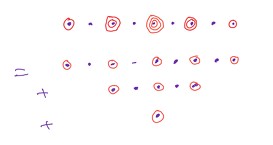3.15. Lecture 15
3.15.1. Decomposing
Example 3.15.1.
Let be the standard representation of with weight basis , . Consider . Let , and be weight vectors in corresponding to the weights , and . Then the weights of are
-
•
, multiplicity one, weight vector: .
-
•
, multiplicity two, weight space: .
-
•
, multiplicity three, weight space: .
-
•
, multiplicity two, weight space: .
-
•
, multiplicity one, weight vector: .

The weights of are and so the weights of are
This is the same as the set of weights of
and so this is the required decomposition into irreducibles.
We can go further, and decompose into irreducible *sub*representations. This means finding irreducible subrepresentations of such that is their direct sum (not just isomorphic to their sum).
The copy of in has highest weight vector . We can find a basis by repeatedly acting with on it (writing for ‘equal up to a non-zero scalar’):
These vectors are a basis for the copy of in .
Next, we find the copy of in . We start by looking for a highest weight vector of weight 2:
does the trick. Hitting this with gives , and doing so again gives (up to scalar). These vectors are a basis for the copy of in .
Finally, we find the trivial representation in . We need only find a weight vector of weight 0 which is killed by , and
does the job. This vector spans a copy of the trivial representation.
3.15.2. Classification of irreducible representations
We have already seen that and are isomorphic (Problem 1.5.2). We therefore have:
Theorem 3.15.2.
There is an irreducible two-dimensional representation of such that the irreducible complex representations of are exactly for .
Proof.
We want to know which of these representations exponentiate to an irreducible representation of . For this, we revisit the connection with .
Let be the bilinear form on defined by
Lemma 3.15.3.
The form is a positive definite bilinear form preserved by the adjoint action of .
Proof.
This is Problem 1.7.3 where we note that . ∎
Corollary 3.15.4.
There is an isomorphism
Proof.
Choosing an orthonormal basis for with respect to identifies the set of linear maps preserving the inner product with . We therefore have a homomorphism
whose kernel is . The derivative of this homomorphism is injective, otherwise there would be a one-parameter subgroup in the kernel of the group homomorphism, and since the Lie algebras have the same dimension we get an isomorphism of Lie algebras. The group homomorphism is therefore surjective, since exponentials of elements of generate the group . ∎
Remark 3.15.5.
Let be the elements of given by
respectively. Up to scalar, these are an orthonormal basis for . Since the derivative of the above homomorphism is the adjoint map, computed with respect to this basis, we see that the induced isomorphism takes:
It will be useful to know where this isomorphism takes the elements of . For example, as , we see that it goes to . Or, for the lowering operator , we have
and similarly .
Corollary 3.15.6.
For each , there is a unique irreducible representation of of dimension with derivative isomorphic to the representation of . This gives the complete list of irreducible representations of up to isomorphism.
Proof.
We simply have to work out which irreducible representations of exponentiate to a representation of . Since we have and each exponentiates to a unique representation of — which we also call — this is equivalent to asking for which the centre of acts trivially on . But we see that acts as , so the answer is for even only.
Thus exponentiates to a representation of if, and only if, is even, and we obtain the result. ∎
We can consider the weights of these representations. Under the isomorphism
the element maps to . Since the -weights of are , we must divide these by to find the weights of acting on :
Example 3.15.7.
Consider the standard three-dimensional representation of on . The weights of are simply its eigenvalues as a matrix, which are . We see that this representation is isomorphic to .
3.15.3. Exercises
Problem 40.
-
(a)
For integers, decompose the representation of into irreducibles. (This is known as the Clebsch–Gordan formula).
-
(b)
(+) Can you find a general expression for the highest weight vectors for the irreducible subrepresentations? What about for the weight bases?